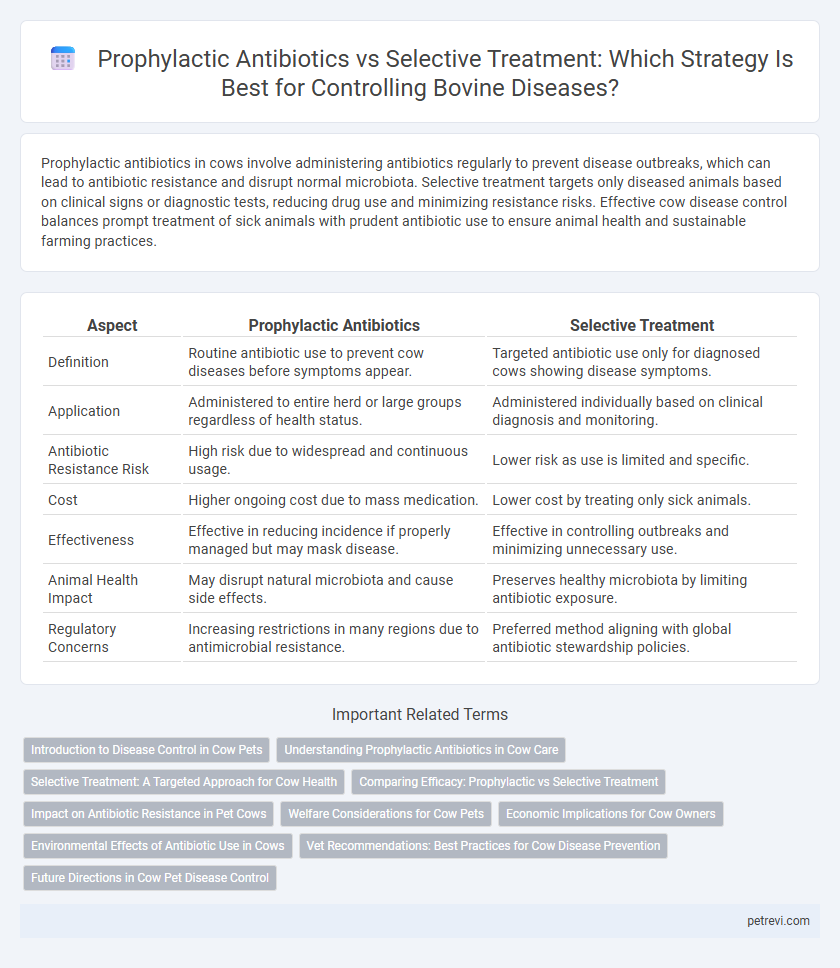Prophylactic antibiotics in cows involve administering antibiotics regularly to prevent disease outbreaks, which can lead to antibiotic resistance and disrupt normal microbiota. Selective treatment targets only diseased animals based on clinical signs or diagnostic tests, reducing drug use and minimizing resistance risks. Effective cow disease control balances prompt treatment of sick animals with prudent antibiotic use to ensure animal health and sustainable farming practices.
Table of Comparison
| Aspect | Prophylactic Antibiotics | Selective Treatment |
|---|---|---|
| Definition | Routine antibiotic use to prevent cow diseases before symptoms appear. | Targeted antibiotic use only for diagnosed cows showing disease symptoms. |
| Application | Administered to entire herd or large groups regardless of health status. | Administered individually based on clinical diagnosis and monitoring. |
| Antibiotic Resistance Risk | High risk due to widespread and continuous usage. | Lower risk as use is limited and specific. |
| Cost | Higher ongoing cost due to mass medication. | Lower cost by treating only sick animals. |
| Effectiveness | Effective in reducing incidence if properly managed but may mask disease. | Effective in controlling outbreaks and minimizing unnecessary use. |
| Animal Health Impact | May disrupt natural microbiota and cause side effects. | Preserves healthy microbiota by limiting antibiotic exposure. |
| Regulatory Concerns | Increasing restrictions in many regions due to antimicrobial resistance. | Preferred method aligning with global antibiotic stewardship policies. |
Introduction to Disease Control in Cow Pets
Prophylactic antibiotics in cow disease control involve administering antibiotics to prevent infection before symptoms appear, aiming to reduce overall disease incidence in herds. Selective treatment targets only cows showing clinical signs of illness, minimizing antibiotic use to prevent resistance and preserve microbiome health. Balancing these approaches is crucial for effective health management in cow pets, optimizing welfare and productivity while mitigating antimicrobial resistance risks.
Understanding Prophylactic Antibiotics in Cow Care
Prophylactic antibiotics in cow care are administered to healthy animals to prevent the onset of infectious diseases, particularly during high-risk periods such as calving or transport. This approach aims to reduce the incidence of bacterial infections like mastitis and respiratory diseases, thereby improving overall herd health and productivity. Understanding the appropriate use and potential risks, including antibiotic resistance, is crucial for effective disease control and sustainable livestock management.
Selective Treatment: A Targeted Approach for Cow Health
Selective treatment in cow disease control targets only individuals showing clinical signs or testing positive for infections, reducing the overall use of antibiotics and minimizing antimicrobial resistance. This approach relies on regular health monitoring, diagnostic testing, and precise identification of affected animals to administer treatment effectively. Implementing selective treatment enhances overall herd health by preserving beneficial microbiota and improving long-term disease management outcomes.
Comparing Efficacy: Prophylactic vs Selective Treatment
Prophylactic antibiotics in cows provide broad prevention against bacterial infections, reducing disease incidence but raising concerns about antimicrobial resistance and residues in milk. Selective treatment targets only clinically affected cows, minimizing antibiotic use and preserving efficacy while requiring accurate diagnosis and careful monitoring. Studies show selective treatment can achieve comparable herd health outcomes to prophylactic use, promoting sustainable disease control and reducing resistance risks.
Impact on Antibiotic Resistance in Pet Cows
Prophylactic antibiotics in pet cows often lead to increased antibiotic resistance due to continuous exposure to antimicrobial agents, promoting resistant bacterial strains. Selective treatment targets only clinically affected animals, reducing overall antibiotic use and thereby minimizing the risk of resistance development. Implementing selective treatment protocols is crucial for sustainable disease control and preserving antibiotic efficacy in pet cow populations.
Welfare Considerations for Cow Pets
Prophylactic antibiotics in cow pets can reduce the incidence of infectious diseases but pose risks of antibiotic resistance and disruption to the natural microbiome, potentially compromising animal welfare. Selective treatment targets only clinically affected cows, preserving gut health and reducing unnecessary drug exposure, which aligns better with welfare-oriented management. Emphasizing selective treatment enhances long-term health outcomes while supporting ethical standards in pet cow care.
Economic Implications for Cow Owners
Prophylactic antibiotics in cows can lead to higher upfront costs and increased risk of antibiotic resistance, impacting long-term herd health and marketability. Selective treatment targets only infected animals, reducing drug expenses and preserving antibiotic efficacy, which benefits overall economic sustainability. Cost-benefit analyses often show selective treatment improves profitability by minimizing unnecessary medication and maintaining milk and meat quality standards.
Environmental Effects of Antibiotic Use in Cows
The use of prophylactic antibiotics in cows leads to significant environmental contamination through the excretion of antibiotic residues and resistant bacteria in manure, which can disrupt soil microbial communities and promote the spread of antimicrobial resistance in surrounding ecosystems. Selective treatment strategies, targeting only clinically affected cows, reduce the overall antibiotic load released into the environment, thereby minimizing negative impacts on biodiversity and decreasing the risk of resistance gene propagation in soil and water systems. Environmental monitoring of antibiotic residues and resistance markers highlights the ecological benefits of selective treatments over blanket prophylactic antibiotic use in sustainable cattle disease management.
Vet Recommendations: Best Practices for Cow Disease Prevention
Veterinarians recommend selective treatment over prophylactic antibiotics for cow disease control to minimize antibiotic resistance and ensure targeted therapy. Best practices emphasize routine health monitoring, vaccination programs, and maintaining proper hygiene to prevent infections. Implementing selective treatment based on diagnostic results aligns with sustainable animal health management and regulatory guidelines.
Future Directions in Cow Pet Disease Control
Emerging strategies in cow pet disease control emphasize reduced reliance on prophylactic antibiotics to combat antimicrobial resistance, favoring selective treatment protocols informed by advanced diagnostic tools and precision medicine. Genomic and microbiome analyses enable targeted interventions, optimizing animal health while minimizing drug use. Future directions include integrating artificial intelligence and real-time health monitoring systems to dynamically adjust treatments, promoting sustainable and effective disease management.
Prophylactic antibiotics vs Selective treatment for Cow disease control Infographic

 petrevi.com
petrevi.com